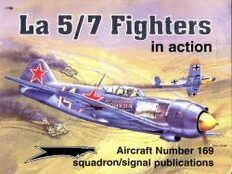
La 5/7 Fighters in Action PDF
51 Pages·17.716 MB·English
Most books are stored in the elastic cloud where traffic is expensive. For this reason, we have a limit on daily download.
Preview La 5/7 Fighters in Action
Description:
La 5/7 Fighters in Action КНИГИ ;ВОЕННАЯ ИСТОРИЯ La 5/7 Fighters in Action (Aircraft Number 169)ByHans-Heiri StapferPublisher:Squadron/Signal Publications Inc.1998 52PagesISBN: 0897473922PDF18 MBThe wooden, radial cngined La-5 fighters from the drawing board of the Lavochkin Design Bureau played a vital role in wresting air superiority from the Luftwaffe on the Eastern front. The top scoring Allied ace. Ivan N. Ko/hedub. claimed all of his 62 aerial victories while flying Lavochkin fighters. Ko/hedub flew his initial combat sorties during OPERATION CITADEL north of Kursk, where he downed four enemy aircraft and claimed his last victim, an Me 262 jet fighter, on 15 February 1945. A considerable number of Soviet aces claimed their kills in Lavochkin fighters. Along with the inline engincd Yakovlev fighters, the Lavochkins were the backbone of the Soviet Fighter Aviation Regiments during the Great Patriotic War. Soviet factories built 9.920 La-5s up to November of 1944 when production switched to the more advanced La-7. The same factories built 5.905 La-7s until production ceased in December of 1945.During the closing years of the 1930s, fighters being produced in the Soviet Union were unique in one respect — no other country was mass producing modern fighters made of wood. Reports from various Soviet research institutes had established that metal, given the same strength requirements, was forty percent lighter than wood. Additionally, the advantages of metal's durability, fire resistance, and ability to withstand severe climatic conditions were well known to Soviet scientists. Nevertheless, the light metal alloys used in Western aircraft construction were in desperately short supply in the USSR, whereas wood was available in nearly unlimited quantities. Additionally, wood did not require the same level of highly skilled labor needed to form and assemble metal alloys. Therefore, it is not surprising that the prototypes of the three modern fighters (LaGG-3. MiG-3 and Yak-1) were all built of wood.The first weeks of war with Nazi Germany had proved the concept of building great quantities of fighters using wood rather than the more sophisticated light metal alloys. After the first few months of the campaign. Soviet production of light alloys had dropped by eighty percent, leaving wood as the primary material in new fighter construction.sharingmatrix letitbit 0
See more
The list of books you might like
Most books are stored in the elastic cloud where traffic is expensive. For this reason, we have a limit on daily download.
